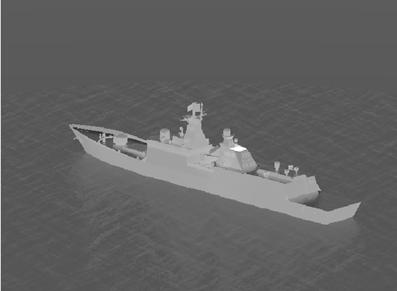The latest release of ThermoAnalytics 2025.1, includes powerful enhancements across our suite of thermal simulation tools: TAITherm, MuSES, and CoTherm. This release underscores our commitment to providing engineers with cutting-edge solutions for tackling complex thermal challenges in advanced applications like cabin comfort, hybrid and electric vehicles, thermal signatures of sea-borne vessels and beyond.
For more detailed information, please refer to the release notes and updated documentation available on our support site. Please contact us with any questions.
Select a logo below to navigate directly to the latest updates for each software:

|

|

|
TAITherm
TAITherm 2025.1 takes a significant leap forward in its ability to seamlessly integrate with third-party tools, enabling efficient multi-physics simulations across various scales. This release builds upon previous advancements in Functional Mockup Unit (FMU*) export and Input/Output Parameter coupling, unlocking new possibilities for human and battery thermal simulations.
*See fmi-standard.org for more information.

Smarter Cabin Simulations with Human Thermal Integration:
Understanding and optimizing cabin comfort just got a whole lot more sophisticated. TAITherm 2025.1 now allows you to incorporate the human element directly into your simulations.
- Whole Body Thermal Sensation and Comfort as Output Parameters: Cabin simulations are now enhanced by taking the human occupants into account. The whole-body thermal sensation and comfort results are available in Output Parameters and exposed on the Functional Mockup Interface (FMI) so that they can be coupled into system modeling tools for the development of comfort-based HVAC controllers. Imagine HVAC systems that respond not just to a target temperature, but to how the occupants feel.
- Anticipating Occupant Behavior: This capability opens the door to simulating occupant behavior over long transient events. A cold occupant is likely to increase the heating, while a warm one will adjust it down. This release provides access to the whole-body comfort and sensation.
- Foundation for Microclimate Optimization: While this release focuses on whole-body comfort, future iterations will provide access to body segment-level results, paving the way for optimizing microclimate devices like heated seats and radiant panels with unprecedented precision.

Enhanced Battery Thermal Management for Hybrid and Electric Vehicles:
Efficient battery thermal management is critical for the performance and longevity of hybrid and battery electric vehicles. TAITherm 2025.1 strengthens the link between battery thermal models and Battery Management System (BMS) simulations.
- Battery Electrical Load as an Input Parameter: You can now directly set the battery electrical load from an Input Parameter, allowing for dynamic coupling with BMS simulations in system-level tools.
- Seamless Data Exchange: Existing Output Parameter types can then be used to send crucial thermal results, such as battery cell temperatures, back to the system simulation environment. This tight integration enables more accurate and comprehensive analysis of battery performance under various operating conditions.



Improved Human Thermal Model Workflow:
Managing complex human thermal models is now more intuitive and robust.
- Body Part Map Integrated into TDF File: The definition of body parts and their corresponding segments is now stored directly within the TAITherm Data File (TDF). This integration streamlines workflows and allows for earlier error detection during the model check process within the user interface. Issues that previously might only surface during the thermal solution phase can now be identified and resolved proactively.
- Automatic Body Part Map Synchronization: Operations that previously could lead to part ID renumbering, such as appending a human model into a cabin model, will now automatically update the body part map, ensuring data integrity and saving valuable user time.
- Backward Compatibility and Flexibility: For users who prefer the traditional method, the body part map can still be exported and imported as a text file from the human dialog or via the command line.


RapidFlow’s Enhanced User Experience:
RapidFlow continues to evolve with user-centric improvements and powerful new capabilities for simulating multiple fluid domains.
- GUI Enhancements: Enjoy a smoother and more efficient workflow with refinements to the RapidFlow user interface.
- Introducing Multiple Fluid Domain Simulation: Fluid domains are still defined within a model using Fluid Parts, but now, rather than that fluid part having a required special name and only being able to have one of them, there is a checkbox to indicate which fluid parts are used to define RapidFlow domains.

- Improved Error Checking: Benefit from clearer and more informative feedback on setup issues, making it easier to identify and resolve configuration problems.
- More Robust Fluid Volume Meshing: The fluid volume mesher is now more tolerant of small gaps in the bounding geometry, reducing the likelihood of unintended fluid leaks.
CFD Imports: Optimized Memory Management for Large Datasets
- Significant Memory Savings: Optimizations have been implemented for models where imported CFD records contain only heat transfer coefficient (h) and fluid temperature (Tf) data, or only velocity (v) and fluid temperature (Tf) data, as well as for models with unique time or vehicle speed values across all records. Users can experience up to 60% memory savings when opening, solving, or displaying imported CFD values in these cases.
- Consistent Performance for Complex Cases: Models with multiple records at the same time value will maintain similar memory requirements as in previous versions.

The green line represents results from 2025.1 while the magenta line reflects previous version.
Distributed Parallel Processing: Greater Flexibility in Compute Environments
- Expanded MPI Library Support: Linux installations now offer a wider range of MPI libraries, including Intel MPI versions 2021 and 2018, MPICH, and OpenMPI. Windows users can choose between Intel MPI 2021 and Microsoft MPI.
- Simplified MPI Configuration: You can now conveniently set your preferred MPI library within the application preferences, in addition to specifying it for command-line runs. This provides greater flexibility and ease of use across different compute environments.

* A support site account is required to access TAI software
MuSES
Building upon the core TAITherm thermal modeling improvements, MuSES 2025.1 introduces specialized features for accurately simulating the thermal signatures of sea-borne vessels.
- Introducing Water Wash Modeling: This capability allows you to simulate the effect of seawater being sprayed onto a ship's hull for cooling purposes, reducing the temperature difference between the vessel and the surrounding environment.
- Enhanced Sea Surface Interactions in Renderings: Achieve more realistic and physically accurate thermal renderings with the ability to account for:
- Thermal Reflections off Structured Sea Surfaces: Capture the thermal reflections of the target on a sea surface.
- Solar Shadowing on Structured Sea Surfaces: Visualize the shadows cast by the vessel onto the moving water surface.
These enhancements combine to produce a more comprehensive and accurate representation of the thermal signatures of maritime targets.
 |
 |
* A support site account is required to access TAI software
CoTherm
CoTherm 2025.1, TAI’s co-simulation and process automation software, empowers users with new and improved capabilities for parallelization of process tasks, categorical DOE variables, and coupling data exchange.
- Faster Parallel Execution with Iteration Sub-Process: For CAE processes involving repetitive tasks like DOE studies or generating large datasets of IR renderings, CoTherm 2025.1 introduces the Iteration Sub-Process. This new compound task container enables the parallel execution of any user-defined set of calculations based on a template and a list of inputs from a CoTherm Table. This process workflow allows effective parallelization of serial calculations or parallelized simulations which do not scale efficiently to many CPUs. The overall set of iterations can be completed in much less time, allowing faster turnaround or more data to be generated for sensitivity analysis, training artificial intelligence/machine learning models, or other applications.
Examples demonstrating parallel BRDF rendering (using MuSES) and parallel DOE analysis (using TAITherm):
Parallel BRDF rendering (generation of massive IR rendering datasets using MuSES for AI/ML or signature analysis) is demonstrated using the new parallel-brdf-rendering example.
- The default example generates a small set of renderings for two fast-running ground vehicle models.
- The process can be extended to any user-provided MuSES models - An Iteration Sub-Process is used to define the template work for one rendering (calling MuSES and converting the resulting data file to a PNG image file).
- The process uses a CoTherm DOE Table to generate a table of rendering parameters varying inputs as defined by the user (e.g. azimuth, elevation, range, time of day, and waveband).

DOE analysis, as demonstrated in the existing thermal-doe-study-sensitivity-surrogate example, has been updated to use an Iteration Sub-Process to execute DOE iterations of a TAITherm thermal simulation
- The Iteration Sub-Process can be configured to run one iteration at a time and use all CPUs for parallelization of the model, or multiple iterations concurrently with the CPUs distributed among the concurrent iterations.
- As before, the DOE iterations can be used to perform statistical analyses / sensitivity studies, train a fast-running surrogate model, or simply generate large sets of output data for any user-provided steady-state or transient model.

Easy Definition of Discrete (Categorical) Variables for DOE Tables: CoTherm DOE Tables now support DOE Defined Choice Columns, allowing users to easily define discrete (categorical) variables alongside continuous ones. This enables more comprehensive DOE studies incorporating various choices or categories. CoTherm's built-in DOE sampling methods (Full Factorial and Optimal Latin Hypercube) have been updated to handle discrete variables, and DOE plots now support their visualization with appropriate labels.
- In the case of Full Factorial, the number of choices will be the number of samples for discrete variables.
- If Optimal Latin Hypercube is used, the total number of samples will be evenly distributed among the choices.
The DOE Defined Choice Column can be used in the process by referencing its choice string, choice index, or normalized value depending on what is convenient to convey the value to models or calculations.
DOE Defined Choice Columns are demonstrated in the existing thermal-doe-study-sensitivity-surrogate example included with CoTherm, which now uses a discrete variable to represent a choice of surface conditions used for the thermal model study.



Intuitive Coupling and Optimization with Electrical and Human Thermal Variables: CoTherm's process variables and Variable Assignment tasks make data exchange intuitive. In 2025.1
- TAITherm Result Variables now support human thermal whole-body output parameters (Berkeley Overall Sensation, Overall Comfort, Fiala DTS, Equivalent Temperature, and PMV). This allows CoTherm processes to easily read these metrics for comfort-based control or optimization.
- TAITherm Input Variables now support TAITherm Input Parameters based on electrical quantities (current or voltage). This enables CoTherm processes to specify dynamic electrical inputs to battery or other thermo-electrical models, facilitating two-way coupling with third-party control schemes or drive cycles and streamlining electrical input-based optimization.
* A support site account is required to access TAI software
For more detailed information, please refer to the release notes and updated documentation available on our support site. Please contact us with any questions.
